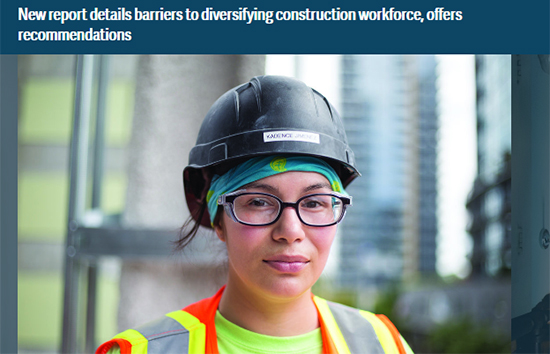Portland Metro Region Construction Workforce Market Study

Oregon Tradeswomen works to increase the number of women and people of color entering the skilled trades, but there are still significant barriers that make recruitment and retention of a challenge. A Workforce Market Study was jointly commissioned in January 2017 by The City of Portland and Metro, (Oregon regional governance and the only one in the nation), with the support of Oregon Tradeswomen, the National Association of Minority Contractors of Oregon (NAMCO), Oregon Employment Department (OED), Portland State University (PSU), and Worksystems Inc. to learn more about how to invest in equitable growth through diversifying our workforce.
Why should we care about diversifying our workforce? The new report states, “Diversifying the construction workforce will not only help create a stronger supply of needed workers for the industry, it will also directly address issues of poverty and economic mobility within communities of color and working families in the region.” The construction industry is also in the midst of a labor shortage. Ideally, we can prepare women and minorities to be those ideal candidates to help fill the labor gap. It isn’t as easy as it seems, though, as the study identifies barriers that make recruitment and retention of these demographics a challenge.
The study outlined 9 main barriers that hinder recruitment and retention of women and minorities in the trades. Many trades jobs come from personal referral, say from a father or friend who is already in the industry. The study shows that women and minorities have less of these gateway experiences. This goes hand in hand with the fact that there are not many communities or social networks within the industry for women and people of color which minimizes the exposure someone from those communities might have to the trades. It was also found that marginalized communities face more hardships than others due to financial issues, child care, transportation, among other things that can stand in the way of them continuing their careers.
Although Oregon Tradeswomen does great work preparing women to join the construction workforce and gives them support throughout their careers, however, there are limits to our capacity to train students, primarily due to structural limitations as to when we can conduct training and offer hands-on experiences to build skills. More than 1,100 women seek our pre-apprenticeship training each year. The problem isn’t that women aren’t interested in a career in construction, but rather, we have a limited number of slots in each cohort. This is a common barrier among pre-apprenticeship and job-readiness programs.
Some of the other barriers that keep women and people of color from continuing a career in the trades are the outdated policies that shape noninclusive jobsite cultures where women and people of color experience sexist and racist attitudes. These policies can foster hostile work environments, poor-quality training for new workers (which then makes it harder for those workers to excel and advance), and fewer opportunities for promotion for women and people of color.
As a way to address the disparity in our region, the study outlined three goals:
- Increase recruitment of diverse workers
- Increase retention of diverse workers
- Develop more robust equity policy and practices
Each of the goals are broken down into action items such as “Ensure steady funding streams to increase capacity of pre-apprenticeship programs,” “Address construction job site culture through respectful workplace trainings with proven results,” and “Enforce contract goals with consequences of non-compliance.”
While there is much work to be done, this study clearly marks a path that we as a community, and hopefully one day as a country, can work towards. There are countless women and people of color who are willing and able to do good work in the construction industry and help fill the labor shortage, but it is the industry as a whole that needs to step up to properly set these workers up for success.
Read the full Portland Metro Region Construction Workforce Market Study.